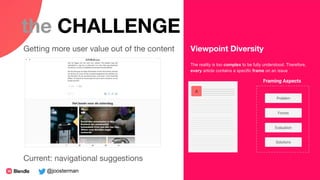Blendle: Diverse recommendations from a vast archive
- 1. @joosterman Diverse recommendations from a vast archive Jasper Oosterman, Data Scientist
- 2. @joosterman@joosterman “Making quality journalism accessible to everyone”
- 4. @joosterman the NUMBERS 160 issues, 100+ NL 10 million euro to publishers 12M articles, 4000/day 80M articles read 1400 hours 40 employees
- 5. @joosterman the TEAM BACKGROUND ● MSc Delft University of Technology ○ Web Information Systems ● PhD Delft University of Technology ○ Crowdsourced Knowledge Generation ● Data Scientist @ Sanoma (3Y) ○ Nu.nl, Viva, Donald Duck ● Data Scientist @ Blendle (2Y ) ○ Alexander Kl?pping HYLKE ALEXIS JASPER
- 6. @joosterman XML Goal: One article format the SYSTEM PDF RSS Manual clipping Convert
- 7. @joosterman Goal: Understanding articles ● Subject matter ○ Topics (economy, health, ...) ○ Named entities (Bitcoin, Max Verstappen, ...) ● Article style ○ Complexity (easy, complex) ○ Feel (positive, negative) ○ Type (Interviews, Opinion Piece) ● Article usefulness ○ What would Editorial do ○ Evergreen ○ Newsiness the SYSTEM ● Document represenation ○ BoW ○ Stylometry ○ Provenance (author, issue) ● Models ○ Spacy for named entities ○ Mostly sklearn ○ Random Forests ● Enrichment process ○ Python workers on K8s ○ Kafka-based communication ○ Autoscaling inside K8s cluster ○ 1s after ingestion
- 9. @joosterman Getting more user value out of the content Current: navigational suggestions the CHALLENGE Framing Aspects Viewpoint Diversity The reality is too complex to be fully understood. Therefore, every article contains a specific frame on an issue
- 10. @joosterman Main problem (1) We are heading for a second corona wave Forces that create or contribute to problem (2) + Evaluation of these forces (3) RIVM is stubborn about mouth masks (-) and Mayors of Amsterdam and Rotterdam take responsibility (+) Possible solutions to the problem (4) There must be a national duty for mouth masks the EXAMPLE
- 11. @joosterman MSc thesis work of Mats Mulder Conceptually: 1. Enrich the article with elements corresponding to each framing aspect 2. Calculate a distance matrix between each pair 3. Rerank using Maximal Marginal Relevance. Take top 3. the RECS
- 12. @joosterman ● Datasets around 4 topics (Corona, Big Tech, BLM, U.S. Election), 50 articles ● Recs baseline: term-based relevance, i.e. most similar, lamda=1 ● Recs variant: viewpoint divers, i.e most divers, lambda=0 ● Identical section title, articles not personalized ● Over 2000 (cherry-picked) users ● 12 days ● 24 recommendations the EXPERIMENT
- 13. @joosterman ● Did the diversity method work? YES The average viewpoint diversity scores across all topics increased from 0.55 to 0.79 for an increasing level of diversity in the MMR algorithm ● Did users consume more or less recommendations? NO we did not ?nd a signi?cant di?erence between the two user groups in terms of click-through rate per recommended article. The same result holds per topic. ● Did users complete more or less opened recommended articles? NO We found no signi?cant di?erence in terms of completion rate for the two user groups ---- ● Multiple presentation properties, such as the inclusion of a thumbnail image and the favourite count, were shown to have a signi?cant in?uence on the click-through rate of recommendations the RESULTS















